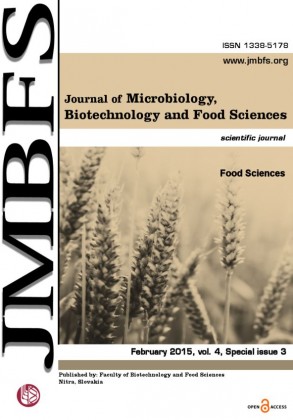QUALITY ASSESSMENT OF EDIBLE TOMATO VARIETIES INTENDED FOR INDUSTRIAL PROCESSING
DOI:
https://doi.org/10.15414/jmbfs.2015.4.special3.114-117Keywords:
Tomato, technological characteristics, dry matter, carotenoids, lycopeneAbstract
Most of the global production of tomatoes is used for tomato products. The fruits to be processed are evaluated on the basis of important technological quality parameters, such as the content of dry matter and organic acids. Recently, among important qualitative characteristics of fruits has been included colorant content, especially lycopene. Aim of this study was to evaluate the quality of selected tomato varieties for industrial processing. Tested were varieties Uno Rosso, San Marzano 4, Brixol, Strombolino, UG. 8168, Diana and Nemarock cultivated in very hot and dry agro-climatic region. The dry matter content was determined by the gravimetric method, the content of organic acid by titration and the content of colorants spectrophotometrically. The dry matter content of the samples ranged from 4.65% (Nemarock) to 5.93% (San Marzano 4). Content of organic acids ranged from 0.33% (Nemarock) to 0.59% (Strombolino), content of carotenoids in tomato samples ranged from 111.288 mg.100 g-1 DM (Nemarock) to 198.365 mg.100 g-1 DM (San Marzano 4). Lycopene was present in the amount of 99.438 mg.100 g-1 DM (Nemarock) to 192.687 mg.100 g-1 DM (San Marzano 4). In terms of treatment the best properties showed San Marzano 4, which is characterized by high dry matter content, low organic acids and high content of colorants.Downloads
Download data is not yet available.
Downloads
Published
2015-02-02
How to Cite
Mendelová, A., Fikselová, M., Mendel, ĽubomÃÂr, Andrejiová, A., MareÄek, J., & Czako, P. (2015). QUALITY ASSESSMENT OF EDIBLE TOMATO VARIETIES INTENDED FOR INDUSTRIAL PROCESSING. Journal of Microbiology, Biotechnology and Food Sciences, 4(special issue 3 (Food Sciences), 114–117. https://doi.org/10.15414/jmbfs.2015.4.special3.114-117
Issue
Section
Food Sciences
License
Copyright (c) 2015 Andrea Mendelová, Martina Fikselová, ĽubomÃÂr Mendel, Alena Andrejiová, Ján MareÄek, Peter Czako

This work is licensed under a Creative Commons Attribution 4.0 International License.
All papers published in the Journal of Microbiology, Biotechnology and Food Sciences are published under a CC-BY licence (CC-BY 4.0). Published materials can be shared (copy and redistribute the material in any medium or format) and adapted (remix, transform, and build upon the material for any purpose, even commercially) with specifying the author(s).





